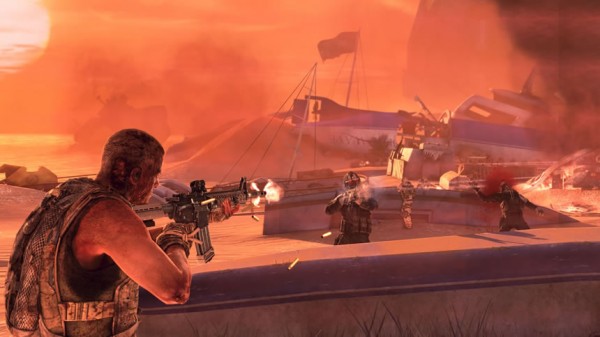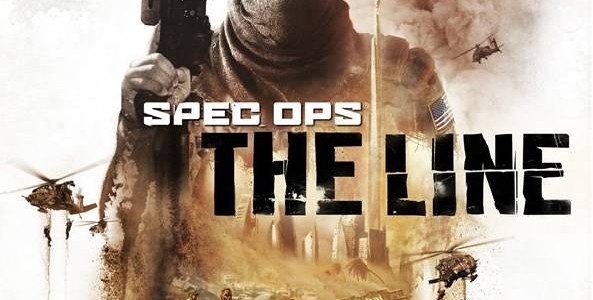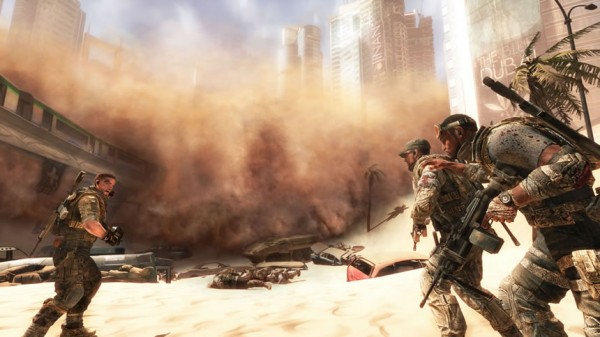GamerNode Public Service Announcement: There be SPOILERS ahead!!
There is only one way to investigate areas and get a closer look at objects and people in the periphery of Spec Ops: The Line: down the barrel of a gun. That may seem trite, and true of most third person shooters, but there’s something different with the feeling – the rule – of it here. While playing, I was uneasy. I rested at several key moments in the game, wondering if I should go back and play them over. I looked down the barrel of my gun with caution rather than my usual brazen eagerness. The game dared me so many times, egging me to just go for it, but I waved my hands at it, acting cool when really I had no clue what would happen next.

Spec Ops: The Line is very aware it is a video game. It’s aware of what it presents you. It’s aware of its violence and its humanity. There’s a VJ character that espouses criticism and irony throughout, using lines like “Where’s all this violence coming from? Is it the video games? I bet it’s the video games,” and “Rated E for Everyone’s Thirsty!” In a less harrowing experience, this would come across cheeky or loose, but here it’s a focused comfort. It’s a reminder that the game is just a game at the end of the day, and it shouldn’t be forgotten. The violence in Spec Ops seems out of the ordinary. In a sense, it is ordinary. And that’s why I find it troubling.
The game centers around a group of Marines sent to Dubai to find a missing battalion of soldiers called the 33rd. At the command of the lost soldiers is a man named Konrad, a war hero and idol of the game’s protagonist, Walker. In their decent, the Marines are changed, battered, confused, burned and eventually torn asunder. The story and gameplay start with what seems like military shooter bliss, a thoughtless mowing of thousands of soldiers – American soldiers – in order to make the game funner. Really, though, the waves of soldiers I was instructed to kill didn’t cheapen the gravitas of the message. Instead, I became more agitated as I played. I became more entrenched. Each approaching soldier boiled down to nothing more than a puff of red smoke when I took aim. They were hurdles and they needed to be knocked down. I was tired of jumping over them.
My patience deteriorated not out of boredom or disinterest, but out of development. Walker and his two squad mates, Lugo and Adams, devolve into something vitriolic as their situation darkens. Their chummy squabbling breaks, splintering into accusations and brutality. Out of the game, I noticed myself getting more frustrated with each death. I lost interest in the optional side quest of collecting Intel for further exposition about the world around me. What started as curiosity to learn about Dubai and its fall became spitting at the screen about wasting my time. I needed to find Konrad, damn it.
Quite a shame, too, because exploring Dubai is a colorful irony. There’s regardless life in the city; sand gusts; sterling light effects; radiant nature. It’s a beautiful backdrop. When I spoke to Lead Writer Walt Williams about the game back at Pax East, he told me that Yager chose Dubai because it could be mistaken for anywhere. The development team hoped that players would assume something about the city because it felt so familiar, which the team could then expose and manipulate. That’s not how I see it. From moment I got to the game’s start menu – which shows an upside down American flag, tattered, waving in the wind as (I believe) Jimi Hendrix’s rendition of “The Star Spangled Banner” plays in the distance – I inched my way through the narrative. I viewed myself an outsider in Dubai. It’s a otherwordly place in the game, stricken with deep layers and polarization.
The same could be said for Spec Ops: The Line as a whole. I mentioned how Spec Ops: The Line is self-aware, and that is proven never more clearly than in its final, jarring moments. I’m still unsure what happens, and I played through it four or so times. What I do know is that I was scared. There’s a moment when Walker is staring, for the first time since the beginning, into a mirror. His face half-charred, he sees – and, not so ambiguously, I see – what has become of this game, which, at that point, resembles nothing of the sort.
Later, in a scene that took me several tries to discover, there is a young American soldier trying to talk Walker down. He’s easing toward him, slowly, his hands are in front of his face; his nervous, young eyes staring right at my crosshairs. The first time I experience this moment, I didn’t fire. The second time, I didn’t fire. Before the third time, I went online and watched the video to see what happens when if you do. Finally, I shot. Puff of red smoke.
Spec Ops: The Line is game about the horrors of war that, on a surface level, ostensibly glorifies it. The game tries showing the darker side of violence, with grim enemy executions that only become grimmer (the type of grim wherein Walker cheers after committing a visceral, intimate kill), but it also requires bullet after bullet be fired until a player can’t be sure if he’s numb of the violence or just unaware of how deep down the rabbit hole he’s fallen. Walker’s descent is something I watched but also helped shape. My removed role in the game became blurry as this was explored. The story’s dizzying evolution had me pondering about my choices. I have no idea if any of it mattered at all. By the final hours, all I could do was stare down my barrel, shrinking, obsessing, wondering: what have I gotten myself into?



















